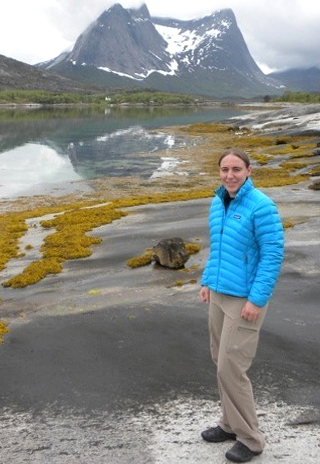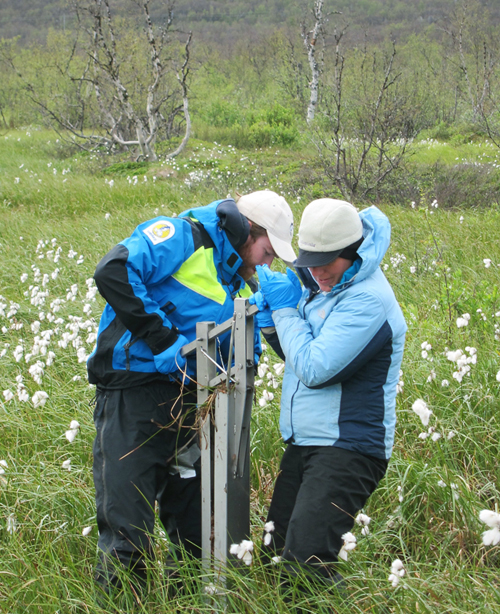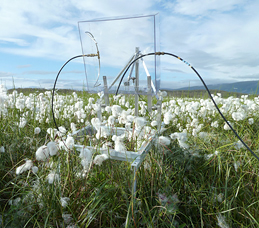Spring 2015
Earth Systems Science
IT TOOK SPHERES nearly two years to finally catch up with Carmody "Carrie" McCalley, who arrived at the Earth Systems Research Center in the fall of 2013 to work with Ruth Varner on trace gas analysis in Sweden and at Sallie's Fen in Barrington, New Hampshire.
Now, she’s heading for greener, tenured pastures at the Rochester Institute of Technology near her old stomping grounds at Cornell University where she earned her doctorate.
On the upside, McCalley, Varner, and others in the ESRC have forged lasting research partnerships that will allow for a variety of collaborative projects well into the future.
“Ruth and I are already plotting,” McCalley says of future joint research opportunities.
Notes Varner, “I am looking forward to continuing our collaboration on current projects as well as those in the future. And we’re already talking about recruiting students from RIT to do research with us here at the ESRC.
The two scientists first crossed paths back in 2010 when McCalley—then a University of Arizona postdoctoral researcher—was studying links between microbes and methane emissions in the peatlands of the Abisko Scientific Research Station in Abisko, Sweden. Varner was also at Abisko doing formative work for the Northern Ecosystems Research for Undergraduates program that she directs.
The NERU work focuses on the impacts of climate change on permafrost and lake environments in the Stordalen mire complex some 124 miles north of the Arctic Circle. Now in its fourth year, the program has thus far provided 30 undergraduates from colleges around the nation with the opportunity to travel abroad, and cut their teeth on state-of-the-art climate change field research. In addition to collaborative fieldwork with Varner at Abisko, McCalley continues to serve as a mentor to undergraduates during summer season field research.
 |
|
| Carrie McCalley at a Norwegian fiord near the Stordalen Mire research site in Abisko, Sweden. Photo by Peggy Hock-McCalley. |
“I believe Carrie’s strong research portfolio as well as her experience working with undergraduates in the NERU program helped prepare her for the RIT position. She came to UNH to continue her research but also to find opportunities to mentor and teach and Carrie has been a critical part of my REU program working closely with me, Mike Palace, and our colleagues in the department of Earth sciences.
McCalley herself did undergraduate research in Arctic climes when she was at Middlebury College in 2002.
“That’s where I got interested in the Arctic work, and when I finished my Ph.D. at Cornell I went back to that,” McCalley says. She adds, “It was a system that always interested me. I actually went to our Abisko site to work as a technician before going to graduate school. I never thought I’d go back again.”
McCalley's journey back to the Stordalen mire was a bit circuitous: at Cornell her Ph.D. work concentrated on desert ecosystems; she then moved to a postdoc position at the University of Arizona and focused her research on Arctic peatland environments.
“Ironically, I started researching desert environments in upstate New York and then later moved to the desert to study the Arctic,” McCalley says. “At Cornell, I studied in the Mojave Desert, flying to Nevada for a couple of weeks at a time to do the work. My Ph.D. advisor had just started a project at the Nevada Test Site where they tested and now dismantle nuclear bombs. Our study site was safe but it was quite restricted as to where we could go.”
Upon completion of her dissertation she then switched it up again—this time moving to the Arizona desert where she again set her sights on Arctic ecosystems.
McCalley’s specialty is trace gas flux measurements and isotope measurements. For her Ph.D. work she measured nitrogen gas fluxes in desert ecosystems.
For their most recent work, McCalley and Varner (whose current research focus is the measurement of trace gas emissions from agricultural and wetland ecosystems) joined forces on two specific grants—a Department of Energy-funded project that starts at the microbial level and scales up to the ecosystem level, and a National Science Foundation macrosystems grant that starts with ecosystems and goes up to the global scale.
“What unites that work with the Arctic and Sallie’s Fen research is measuring gas fluxes and thinking about how those fluxes are changing in response to climate change,” McCalley notes.
Climate change, she adds, is the motivating reason for asking the questions about the biosphere/atmosphere feedbacks that are at the heart of the field measurements.
“The atmosphere is changing, the climate is changing, and all that impacts how ecosystems work. And I’m particularly interested in how that affects how ecosystems function in ways that change the production of chemically important gases—greenhouse gases or other reactive gases.”
The key greenhouse gas here is methane, which is also the focus of Varner’s work in Sweden. The emission of methane from peatlands as the landscape warms and thaws under climate change is of concern to scientists because, while it is less abundant than carbon dioxide, it is many times more potent as a greenhouse gas and there is the potential for substantial amounts of it to be released under the right conditions. Current research is aimed at getting a more accurate handle on what conditions promote emissions in rapidly changing Arctic systems.
 | |
| Carrie McCalley and Tyler Logan collect a peat core for microbial community analysis. Photo by Ruth Varner, UNH-EOS. |
To that end, McCalley has been investigating the influence of microbes in the methane emission process in Arctic peatlands using isotopic analysis. Recently, based on work done as a postdoc at the University of Arizona, she was lead author on a paper published in Nature that detailed the surprise finding that one previously unknown species of microbe dominated the peatland landscape and was an important, unsuspected player in the methane emission process at their test site in Sweden.
“Often, when you read the literature on microbes they tend to look at orders or classes or families, not single species,” McCalley says. “We expected groups of microbes would matter so it was surprising and interesting to find that a single species played such big a role.”
Essentially, according to McCalley, what the research detailed in Nature shows is that methane emissions from thawing permafrost is large enough “that getting the specific microbial isotopic signature right could matter for how you interpret global methane in the atmosphere going forward.”
Microbiology is, of course, a well-established scientific field but the detailed microbial studies McCalley and others do today is relatively new and is due to rapid advances in technology.
“It’s very difficult to study microbes without looking at DNA, and the technology to do the DNA sequencing has been dropping in price exponentially in the past few years,” McCalley notes. “These great advances in the technology and huge reductions in the cost means it’s been a very rapidly developing field and we’re now able to ask these kinds of questions at the microbial level.”
She adds, “In the past, we’ve made hypotheses about what the microbes are doing and how they’re changing based on what we see in terms of fluxes in isotopes, and now we can start testing those hypotheses and eventually use this information to improve models.”
Notes Varner, “Through Carrie’s research and teaching, students at RIT will be exposed to a state-of-the-art understanding of ecosystems using links between geochemistry and microbiology. Moreover, Carrie’s move there won’t be a loss for EOS and UNH. Rather, it will be an opportunity for UNH to engage more—and a more diverse group of—students.”
